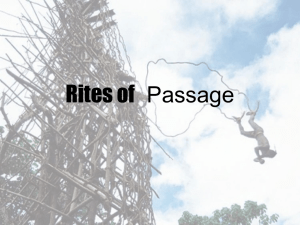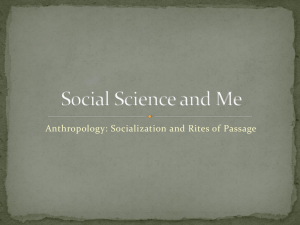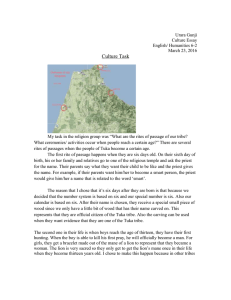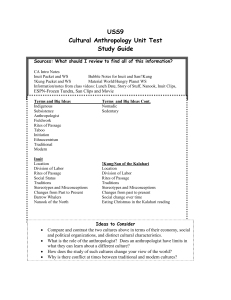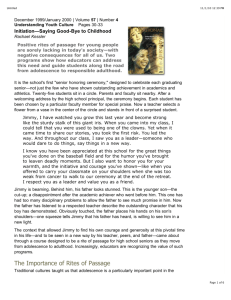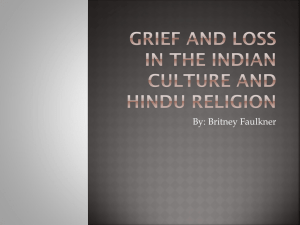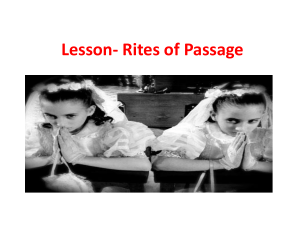Rites of Passage: Cultural Rituals & Transitions
advertisement
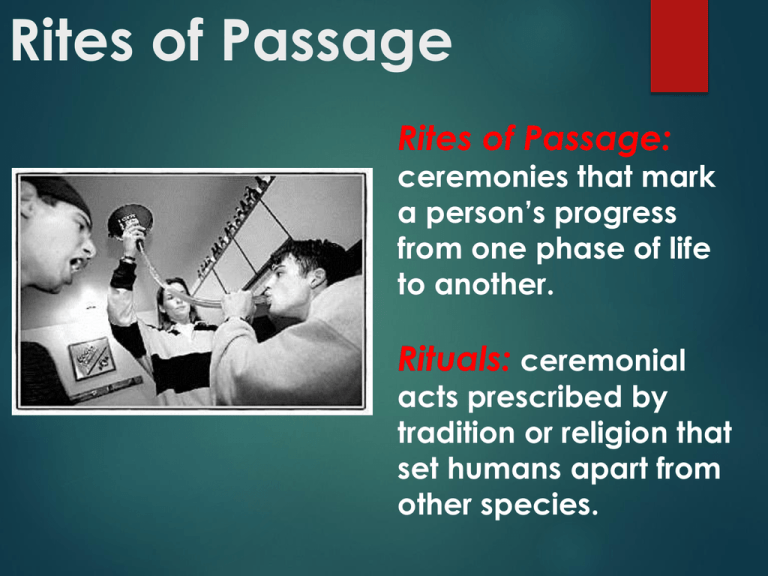
Rites of Passage Rites of Passage: ceremonies that mark a person’s progress from one phase of life to another. Rituals: ceremonial acts prescribed by tradition or religion that set humans apart from other species. Rites of Passage All cultures mark changes/transitions in the life cycle. Some rites of passage are ancient (entering adulthood) Entering adulthood in Sepik River, New Guinea: Crocodile scarification marking transition into manhood ...Maori tattoos , New Zealand ...Land Diving in Pentecost Island while others are very recent… (obtaining a driving license). ...First car ...First time getting drunk The term rites of passage was coined by ethnographer Arnold van Gennep. Although rites of passage are all very different, each one shares a three stage process: 1. Separation - You are temporarily removed from society 2. Transition - You learn the roles and expected behaviours of the new stage you are entering. 3. Incorporation - You are re-admitted back into society as a different person. Reasons for Rites Relieve stress and help understand growth. Group cohesion: everybody goes through the same things. Source of entertainment. Pass on important traditions, religious or moral values. Coming of Age Ceremonies Some of the most important rites of passage are coming-of-age ceremonies. Marks the transition from childhood to adulthood. Anthropologists believe that initiation into puberty is universal; happens all over the world throughout time. Initiations •Puberty rites all over the world share many common features. •May involve mutilation-scarring, piercing, tattooing, endurance, fasting, pain, seclusion, ritual markings, clothing, new name, etc. •Emphasis on instruction in proper adult behaviour. Male Initiation in Australia •Alkira-Kiuma Ceremony or the Tossing Ceremony of the Aranda Tribe (1904). •At age twelve, the boy's first initiation ceremony, tossed up and caught by various males tribe members. Having already gone through the ceremony of circumcision some six weeks earlier, the Parra ceremony of sub incision follows. Newly sub-incised men rubbing their blood on the backs of others, of the Aranda Tribe (1944). Tooth Knocking-Out Ceremony, as an additional, optional initiation into the Rain Totem of the Aranda Tribe. The right upper incisor would be knocked out with a stone. Death and Grieving In many ways death is the most significant rite of passage. It is a phase of the life-cycle/rite of passage that all humans go through. The inevitability of death means that people prepare themselves for death throughout their lives. 30,000 year old burial of two infants in present day Austria. Many people believe that death is just another transition to one phase of life to the next. Accordingly, some culture include grave goods to accompany the soul. Many cultures believe in the afterlife where souls are sent following death-often the location depends on earthly behaviour. i.e. Christianity Other cultures believe in the concept of reincarnation-the soul lives on in another living being. Funerary Rites Every society has different customs for the preparation and disposal of the dead. The body is usually washed, shaved, cleansed, blessed… The body is then typically inhumed (buried) or cremated (burned) but other methods include mummification or left to the elements. This process is often accompanied by ceremonies for the mourners i.e mass. Some cultures see death as a sad event while others view it as a joyful occasion. Terracotta Army guarding burial of Qin Shi Huang, first emperor of China 210-209 BC. Death Elizabeth Kubler-Ross’s Stages of Death / Grief. 1. Denial 2. Anger 3. Bargaining 4. Depression 5. Acceptance

